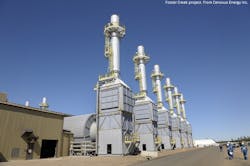Cenovus Energy’s capital spending budget down 19% for 2016
Cenovus Energy Inc., Calgary, expects to invest $1.4-1.6 billion in 2016. While allowing for the planned completion of well-advanced oil sands growth projects next year, the planned budget represents a 19% decrease in capital spending compared with total forecast spending for 2015.
“We expect to meet or exceed all of the operating, cost reduction, and financial targets we set for ourselves in 2015, leaving us well-positioned for what we anticipate will be another volatile year ahead,” said Brian Ferguson, Cenovus president and chief executive officer. “Even if Brent crude prices remain in the $40[/bbl] range through 2016, we believe we can continue to fund our sustaining capital program, growth projects that are nearing completion and our current dividend level.”
Cenovus expects 80% of its 2016 budget to be directed toward sustaining capital investments, with the remaining 20% expected to be allocated predominantly to oil sands growth projects.
At Cenovus’s conventional oil operations, the bulk of planned 2016 capital spending is expected to go towards maintaining and optimizing current oil production volumes. Minimal capital spending is anticipated at the company’s heavy oil operations at Pelican Lake.
Cenovus says it also continues to invest in its refining business, as integration is an important part of the company’s overall strategy. The 2016 budget for Cenovus’s Wood River and Borger refineries in the US, which are jointly owned with operator Phillips 66, includes capital for the debottlenecking project at Wood River. This project is expected to be completed in the third quarter, increasing heavy oil processing capacity by 18,000 b/d gross.
Christina Lake, Foster Creek projects
With the Christina Lake optimization project completed on time and under budget during this year’s fourth quarter, Cenovus says it’s now concentrating on delivering its two oil sands growth projects that are already far along in the construction process. The Foster Creek Phase G and Christina Lake Phase F expansions are on track with first oil from both projects anticipated in third-quarter 2016.
As part of its growth plans, the company has a regulatory application pending for a Phase H expansion at Christina Lake (OGJ Online, Aug. 29, 2013). Cenovus says it anticipates approval of the project.
While operating costs at Christina Lake and Foster Creek are expected to be slightly higher in 2016 compared with Cenovus's forecast for 2015, the company anticipates costs will remain about 15% lower than they were in 2014.
The expected cost increase from 2015 to 2016 is largely due to planned turnarounds and temporarily higher per-barrel costs associated with bringing on new production. The company has three planned turnarounds scheduled for 2016. There were no turnarounds at the company's oil sands operations in 2015.
Cenovus expects continued 2016 oil sands production growth of 7% compared with its anticipated 2015 production. Oil sands production is expected to be impacted by the planned turnarounds, offset by expected incremental volumes from Foster Creek Phase G as well as the optimization project and Phase F expansion at Christina Lake.
“With two new oil sands expansions nearing completion and the Christina Lake optimization finished, we're on track to increase our total net production capacity by approximately 35%, or 50,000 [b/d],” said Ferguson. “We should begin to see incremental production from those expansions in the second half of 2016, with more significant volumes expected to come on stream in 2017.”
Cenovus’s conventional oil production in 2016 is expected to be 15% lower than its forecast production in 2015, largely due to the impact of the $3.3-billion sale of its royalty interest and fee lands business in July of this year (OGJ Online, July 6, 2015), and expected natural declines. Total oil production is expected to remain consistent with 2015.
Cost reductions, risk management
The company says savings have been realized in capital costs, including improved drilling efficiency and optimized scheduling and prioritization of repair and maintenance activities, as well as reduced chemical costs and better oil sands waste disposal and handling processes.
In 2016, the company will continue to focus on achieving additional cost reductions, including plans to move to a redesign of production facilities for new oil sands well pads. Building on lessons learned from operating commercial steam-assisted gravity drainage (SAGD) oil sands projects for nearly 15 years, Cenovus says it expects this design approach will significantly reduce the scope and cost of infrastructure required for new well pads.
Cenovus currently has 15% of its 2016 oil production hedged at a volume-weighted average price of about $80/bbl (Can.). Through a combination of hedging, market access commitments, and downstream integration largely provided by the company's two US refineries, Cenovus has positioned itself to mitigate the impact of swings in the Canadian light-heavy oil price differential for more than 85% of its anticipated 2016 heavy oil production, the company says.


